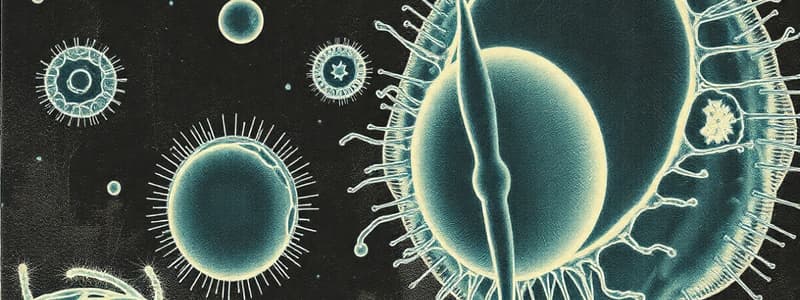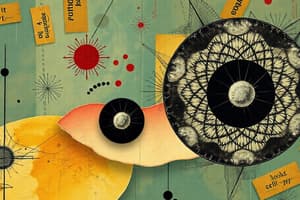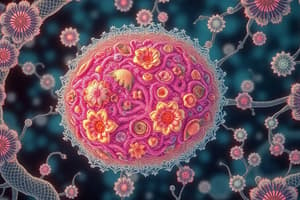Podcast
Questions and Answers
Which of these email addresses should be used to reach the instructor with a question when including 'PCB3134' in the subject line?
Which of these email addresses should be used to reach the instructor with a question when including 'PCB3134' in the subject line?
Which of the following is a scheduled office hour for one of the Learning Assistants?
Which of the following is a scheduled office hour for one of the Learning Assistants?
- Thursdays 10:00 AM - 12:00 PM
- Fridays 3:30 PM - 4:30 PM (correct)
- Mondays 3:00 PM - 4:00 PM
- Wednesdays 1:15 PM - 2:15 PM
According to the course objectives, which of the following statements is most accurate?
According to the course objectives, which of the following statements is most accurate?
- The course emphasizes practical laboratory skills over theoretical concepts
- The course primarily aims to prepare students for chemistry related careers
- The course focuses on detailed knowledge of ecological systems
- The course is designed to help students understand eukaryotic cell biology and prepare for standardized tests (correct)
Which of the following is NOT mentioned as a general property of life from the list provided?
Which of the following is NOT mentioned as a general property of life from the list provided?
Which course is explicitly listed as the most useful in preparation for the course, besides the required ones?
Which course is explicitly listed as the most useful in preparation for the course, besides the required ones?
What percentage of the final grade is determined by the five unit exams?
What percentage of the final grade is determined by the five unit exams?
If a student scores between 87 and 89.99 total points, what letter grade will they receive?
If a student scores between 87 and 89.99 total points, what letter grade will they receive?
What is the total point value allocated to the in-class assignments?
What is the total point value allocated to the in-class assignments?
Besides attending class, what else must students do to potentially earn extra credit points through in-class activities?
Besides attending class, what else must students do to potentially earn extra credit points through in-class activities?
What type of questions can students expect on the unit exams?
What type of questions can students expect on the unit exams?
How many points is the final exam (E5) worth?
How many points is the final exam (E5) worth?
What is the best strategy to ensure exam success, according to the syllabus?
What is the best strategy to ensure exam success, according to the syllabus?
What is the total number of points available in the course?
What is the total number of points available in the course?
Which of the following best describes the function of macromolecules within a cell?
Which of the following best describes the function of macromolecules within a cell?
What is the primary purpose of cellular compartmentalization?
What is the primary purpose of cellular compartmentalization?
Which cellular process is directly associated with ATP synthesis?
Which cellular process is directly associated with ATP synthesis?
What is the main function of the cell cytoskeleton, extracellular matrix, and cell junctions?
What is the main function of the cell cytoskeleton, extracellular matrix, and cell junctions?
Which of the following best describes the role of DNA in the cell?
Which of the following best describes the role of DNA in the cell?
What is the purpose of DNA replication in a cell cycle?
What is the purpose of DNA replication in a cell cycle?
What cellular process is involved in converting genetic information into proteins?
What cellular process is involved in converting genetic information into proteins?
Why is the regulation of gene expression essential for the cell?
Why is the regulation of gene expression essential for the cell?
According to the presented information, what is a recommended strategy for improving memory and understanding of the course material?
According to the presented information, what is a recommended strategy for improving memory and understanding of the course material?
If a student feels uncomfortable answering a question during the class, who should they call upon according to the guidelines?
If a student feels uncomfortable answering a question during the class, who should they call upon according to the guidelines?
What was the primary contribution of Anton van Leeuwenhoek to the field of cell biology?
What was the primary contribution of Anton van Leeuwenhoek to the field of cell biology?
What is the main purpose of the short break during the class?
What is the main purpose of the short break during the class?
According to content provided, which was the main contribution of Virchow to cell theory?
According to content provided, which was the main contribution of Virchow to cell theory?
Which scientific approach focuses primarily on the identification of molecules and their functions?
Which scientific approach focuses primarily on the identification of molecules and their functions?
What technique is primarily used in biochemistry to separate different macromolecules?
What technique is primarily used in biochemistry to separate different macromolecules?
Which statement correctly summarizes the central dogma of molecular biology?
Which statement correctly summarizes the central dogma of molecular biology?
Which microscopy technique allows us to visualize atomic structures in biomolecules?
Which microscopy technique allows us to visualize atomic structures in biomolecules?
Who proposed the double helix model for DNA structure?
Who proposed the double helix model for DNA structure?
What is the primary purpose of recombinant DNA technology?
What is the primary purpose of recombinant DNA technology?
Which of the following is NOT a focus of the genetics strand in modern cell biology?
Which of the following is NOT a focus of the genetics strand in modern cell biology?
What is the main outcome of mass spectrometry in biochemistry?
What is the main outcome of mass spectrometry in biochemistry?
Which method is used for analyzing interactions among proteins in a cell?
Which method is used for analyzing interactions among proteins in a cell?
Which of these describes transcriptomics in cell biology?
Which of these describes transcriptomics in cell biology?
Flashcards
Movement
Movement
The ability to change position or location, either independently or through internal movement.
Duplicate
Duplicate
The process by which living things produce offspring, ensuring the continuation of their species.
Growth
Growth
An increase in size or mass, often accompanied by an increase in complexity.
Translate
Translate
Signup and view all the flashcards
Co-operate
Co-operate
Signup and view all the flashcards
Macromolecules
Macromolecules
Signup and view all the flashcards
Organelles
Organelles
Signup and view all the flashcards
Cell membrane
Cell membrane
Signup and view all the flashcards
Fermentation
Fermentation
Signup and view all the flashcards
Cell signaling
Cell signaling
Signup and view all the flashcards
Cytoskeleton
Cytoskeleton
Signup and view all the flashcards
Transcription
Transcription
Signup and view all the flashcards
Translation
Translation
Signup and view all the flashcards
What is the core idea of the Cell Theory?
What is the core idea of the Cell Theory?
Signup and view all the flashcards
What did Virchow add to the Cell Theory?
What did Virchow add to the Cell Theory?
Signup and view all the flashcards
What tools did Hooke and Leeuwenhoek use to study cells?
What tools did Hooke and Leeuwenhoek use to study cells?
Signup and view all the flashcards
How can learning assistants help you?
How can learning assistants help you?
Signup and view all the flashcards
What is the best way to take notes?
What is the best way to take notes?
Signup and view all the flashcards
Grade Breakdown
Grade Breakdown
Signup and view all the flashcards
Key Concepts
Key Concepts
Signup and view all the flashcards
Unit Exams
Unit Exams
Signup and view all the flashcards
Reading/Writing Assignments
Reading/Writing Assignments
Signup and view all the flashcards
In-Class Activities
In-Class Activities
Signup and view all the flashcards
Summary of Scores
Summary of Scores
Signup and view all the flashcards
Full Points in any exam
Full Points in any exam
Signup and view all the flashcards
Assessment Weight
Assessment Weight
Signup and view all the flashcards
What is Cell Biology?
What is Cell Biology?
Signup and view all the flashcards
What is Cytology?
What is Cytology?
Signup and view all the flashcards
What is Biochemistry?
What is Biochemistry?
Signup and view all the flashcards
What is Genetics?
What is Genetics?
Signup and view all the flashcards
What is the Cell Theory?
What is the Cell Theory?
Signup and view all the flashcards
What are microscopes?
What are microscopes?
Signup and view all the flashcards
What is light microscopy?
What is light microscopy?
Signup and view all the flashcards
What is electron microscopy?
What is electron microscopy?
Signup and view all the flashcards
What is subcellular fractionation?
What is subcellular fractionation?
Signup and view all the flashcards
What is electrophoresis?
What is electrophoresis?
Signup and view all the flashcards
Study Notes
Course Information
- Course Title: Cell Structure & Function
- Course Code: PCB3134
- Instructor: Dr. Ashwanth Francis, Ph.D.
- Teaching Assistant: Jonathan Andino
- Meeting Time: Mondays and Wednesdays 3:00 PM - 4:20 PM
- Location: WJB 2004
- Office Hours:
- Instructor: By appointment only, Fridays 1-2 PM, via Zoom (https://fsu.zoom.us/j/2985174687), Email: [email protected]
- Teaching Assistant: Fridays 10:00 AM-12:00 PM, in-person (location TBD), Email: [email protected]
Learning Assistants (LAs)
- Isabelle Cueli: Thursdays 3:30 PM - 4:30 PM, via Zoom, Email: [email protected]
- Sonya Ottich: Fridays 3:00 PM - 4:00 PM, via Zoom, Email: [email protected]
- Carter Johnson: Fridays 1:15 PM - 2:15 PM, via Zoom, Email: [email protected]
- Camila Roman: Fridays 3:00 PM - 4:00 PM, via Zoom, Email: [email protected]
Course Description & Objectives
- Objective 1: Introduce the organization and functional mechanisms of eukaryotic cells.
- Objective 2: Describe the parts of cells in relation to current cell biology.
- Objective 3: Provide self-education opportunities in the rapidly developing field of cell biology.
- Objective 4: Cover key concepts frequently appearing in standardized tests (MCAT and GRE subject tests).
Course Requirements
- Prerequisites: BSC2010, BSC2011, BSC2011L, CHM1046 (PCB3063 Genetics recommended)
Essential Life Properties
- Movement
- Duplication
- Growth
- Translation
- Cooperation
- Environment modification
- Environment response
Course Overview - Content
- Macromolecules: Proteins, nucleic acids, polysaccharides, lipids, enzymes.
- Cells & Organelles: Cellular component structures, function, and transport.
- Cellular Energetics: Glycolysis, fermentation, and aerobic fermentation.
- Cell Signaling: Cytoskeleton, cell mobility, extracellular matrix, and cell junctions.
- DNA & The Nucleus: DNA replication, cell cycle, mitosis, meiosis, gene expression, transcription and RNA processing, translation and protein sorting, regulation of gene expression.
Course Schedule
- The schedule outlines dates, days, topics, and assigned portions from the textbook.
- Exams are scheduled.
Course Grading
- Exams: Five Unit Exams (160 points total), 80% of the grade. Exam format includes multiple choice, true/false, and short answer.
- Reading Assignments: 3 in-class reading/writing assignments (40 points total), 20% of the grade. Assignments cover in-class material. Full points expected.
- In-class Activities: Additional in-class activities/questions (20 points total), 5% of grade. Points awarded for attending class, answering questions, and correct answers.
How to study
- Lectures are recorded and posted after class.
- Follow the slides.
- Take detailed notes, including additional research.
- Re-read notes and review the subject matter.
- Utilize Learning Assistants
- Study for exams
Additional Information
- Course materials are available on Canvas.
Studying That Suits You
Use AI to generate personalized quizzes and flashcards to suit your learning preferences.




